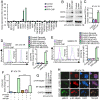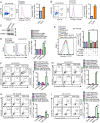Mixed lineage kinase 3 and CD70 cooperation sensitize trastuzumab-resistant HER2+ breast cancer by ceramide-loaded nanoparticles
- PMID: 36095190
- PMCID: PMC9499572
- DOI: 10.1073/pnas.2205454119
Mixed lineage kinase 3 and CD70 cooperation sensitize trastuzumab-resistant HER2+ breast cancer by ceramide-loaded nanoparticles
Abstract
Trastuzumab is the first-line therapy for human epidermal growth factor receptor 2-positive (HER2+) breast cancer, but often patients develop acquired resistance. Although other agents are in clinical use to treat trastuzumab-resistant (TR) breast cancer; still, the patients develop recurrent metastatic disease. One of the primary mechanisms of acquired resistance is the shedding/loss of the HER2 extracellular domain, where trastuzumab binds. We envisioned any new agent acting downstream of the HER2 should overcome trastuzumab resistance. The mixed lineage kinase 3 (MLK3) activation by trastuzumab is necessary for promoting cell death in HER2+ breast cancer. We designed nanoparticles loaded with MLK3 agonist ceramide (PPP-CNP) and tested their efficacy in sensitizing TR cell lines, patient-derived organoids, and patient-derived xenograft (PDX). The PPP-CNP activated MLK3, its downstream JNK kinase activity, and down-regulated AKT pathway signaling in TR cell lines and PDX. The activation of MLK3 and down-regulation of AKT signaling by PPP-CNP induced cell death and inhibited cellular proliferation in TR cells and PDX. The apoptosis in TR cells was dependent on increased CD70 protein expression and caspase-9 and caspase-3 activities by PPP-CNP. The PPP-CNP treatment alike increased the expression of CD70, CD27, cleaved caspase-9, and caspase-3 with a concurrent tumor burden reduction of TR PDX. Moreover, the expressions of CD70 and ceramide levels were lower in TR than sensitive HER2+ human breast tumors. Our in vitro and preclinical animal models suggest that activating the MLK3-CD70 axis by the PPP-CNP could sensitize/overcome trastuzumab resistance in HER2+ breast cancer.
Keywords: CD70; MLK3; apoptosis; breast cancer; trastuzumab resistance.
Conflict of interest statement
The authors declare no competing interest.
Figures







References
-
- Sung H., et al. , Global cancer statistics 2020: GLOBOCAN estimates of incidence and mortality worldwide for 36 cancers in 185 countries. CA Cancer J. Clin. 71, 209–249 (2021). - PubMed
-
- Renoir J. M., Marsaud V., Lazennec G., Estrogen receptor signaling as a target for novel breast cancer therapeutics. Biochem. Pharmacol. 85, 449–465 (2013). - PubMed
-
- Fisher B., et al. , Tamoxifen for the prevention of breast cancer: Current status of the National Surgical Adjuvant Breast and Bowel Project P-1 study. J. Natl. Cancer Inst. 97, 1652–1662 (2005). - PubMed
-
- Carey L. A., et al. , The triple negative paradox: Primary tumor chemosensitivity of breast cancer subtypes. Clin. Cancer Res. 13, 2329–2334 (2007). - PubMed
Publication types
MeSH terms
Substances
Grants and funding
LinkOut - more resources
Full Text Sources
Medical
Research Materials
Miscellaneous

